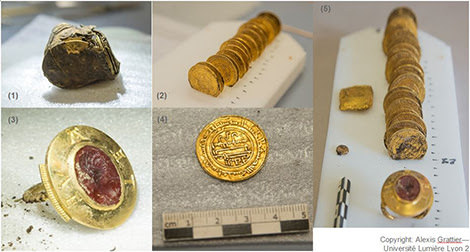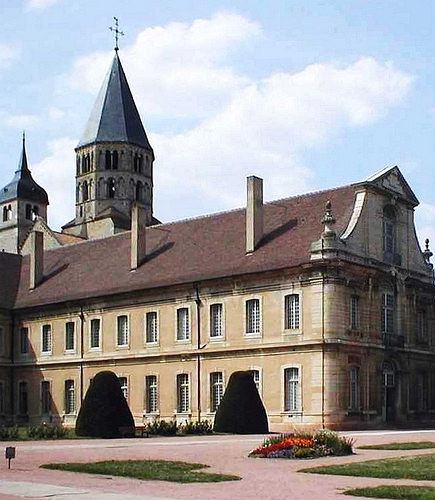
In mid-September, a large treasure was unearthed during a dig at the Abbey of Cluny, in the French department of Saône-et-Loire: 2,200 silver deniers and oboles, 21 Islamic gold dinars, a signet ring,1 and other objects made of gold. Never before has such a large cache of silver deniers been discovered. Nor have gold coins from Arab lands, silver deniers, and a signet ring ever been found hoarded together within a single, enclosed complex.
Anne Baud, an academic at the Université Lumière Lyon 2, and Anne Flammin, a CNRS engineer—both from the Laboratoire Archéologie et Archéométrie (CNRS / Université Lumière Lyon 2 / Claude Bernard Lyon 1 University)—led the archaeological investigation, in collaboration with a team of 9 students from the Université Lumière Lyon 2 and researchers from the Maison de l’Orient et de la Méditerranée Jean Pouilloux (CNRS / Université Lumière Lyon 2).
The excavation campaign, authorized by the Bourgogne–Franche-Comté Regional Department of Cultural Affairs (DRAC), began in mid-September and ended in late October. It is part of a vast research program focused on the Abbey of Cluny. Students in the Master of Archaeology and Archaeological Science program at the Université Lumière Lyon 2 have been participating in archaeological digs at the Abbey of Cluny since 2015. This experience in the field complements their academic training and gives them an insight into professional archaeology.
At the site, the team, led by Anne Baud et Anne Flammin, including the students from the Université Lumière Lyon 2, discovered a treasure consisting of more than 2,200 silver deniers and oboles—mostly minted by the Abbey of Cluny and probably dating to the first half of the 12th century—in a cloth bag, traces of which remain on some of the coins; and a tanned hide bundle, found among the silver coins, fastened with a knot, enclosing:
- 21 Islamic gold dinars struck between 1121 and 1131 in Spain and Morocco, under the reign of Ali ibn Yusuf (1106–1143), who belonged to the Berber Almoravid dynasty.
- a gold signet ring with a red intaglio depicting the bust of a god and an inscription possibly dating the ring back to the first half of the 12th century
- a folded sheet of gold foil weighing 24 g and stored in a case
- a small circular object made of gold
Vincent Borrel, a PhD student at the Archaeology and Philology of East and West (CNRS / ENS) research unit—AOROC for short—is currently studying the treasure in more detail to identify and date the various pieces with greater precision.
A precious find . . .
This is an exceptional find for a monastic setting and especially for Cluny, which was one of the largest abbeys of Western Europe during the Middle Ages. The treasure was buried in fill where it apparently remained for 850 years. It includes items of remarkable value: 21 gold dinars and a signet ring, a very expensive piece of jewelry that few could own during the Middle Ages. At that time, Western currency was mostly dominated by the silver denier. Gold coins were reserved for rare transactions. The 2,200 or so silver deniers, struck at Cluny or nearby, would have been for everyday purchases. This is the largest stash of such coins ever found. The fact that Arab currency, silver deniers, and a signet ring were enclosed together makes this discovery all the more interesting.
. . . opening new avenues of research into the history of the Abbey of Cluny
This discovery will breathe new life into research delving into the past of the abbey, a historic site open to the public and managed by the Centre des Monuments Nationaux (CMN). It also raises new questions worth answering:
– Who owned the treasure? Was it a monk, a church dignitary, or a rich layman?
– What can the coins teach us? Where were the silver deniers of Cluny struck? Where did they circulate? How did Islamic dinars minted in Spain and Morocco end up at Cluny?
– Why was the treasure buried?
– What building lay above the treasure when it was hidden? Was it a building, now in ruins, that we know little about?
________________________________________
Above: (1) Knotted tanned hide bundle before extraction of contents; (2) & (4) gold dinars; (3) signet ring with intaglio; (5) contents of knotted tanned hide bundle. © Alexis Grattier— Université Lumière Lyon 2
_______________________________________________
The Abbey of Cluny. Marc Tobias Wenzel, Wikimedia Commons
_____________________________________________________
Article Source: A CNRS and Université Lumière Lyon 2 press release
________________________________________
1 The use of signet rings during the Middle Ages is frequently attested. They served various domestic functions, being used to seal coffers, money pouches, and correspondence.
_________________________________________________
Receive 30 days free access to the popular new CuriosityStream lineup of documentaries on science, history, nature, and technology as a new Popular Archaeology premium subscriber.
___________________________________________
Travel and learn with Far Horizons.
____________________________________________








